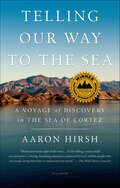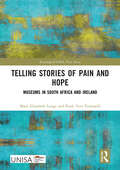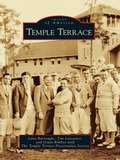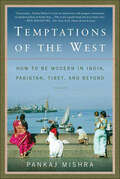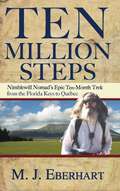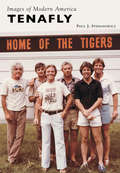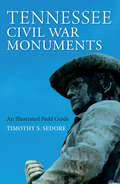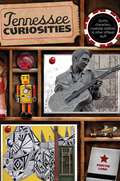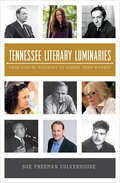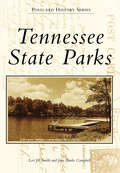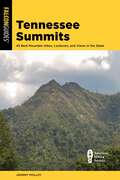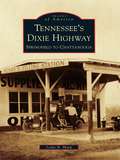- Table View
- List View
Tell My Horse: Voodoo and Life in Haiti and Jamaica
by Zora Neale HurstonAs a first-hand account of the weird mysteries and horrors of voodoo, Tell My Horse is an invaluable resource and fascinating guide. Based on Zora Neale Hurston's personal experiences in Haiti and Jamaica, where she participated as an initiate rather than just an observer of voodoo practices during her visits in the 1930s, this travelogue into a dark world paints a vividly authentic picture of ceremonies and customs and superstitions of great cultural interest.
Telling Our Way to the Sea: A Voyage of Discovery in the Sea of Cortez
by Aaron HirshA luminous and revelatory journey into the science of life and the depths of the human experienceBy turns epic and intimate, Telling Our Way to the Sea is both a staggering revelation of unraveling ecosystems and a profound meditation on our changing relationships with nature—and with one another.When the biologists Aaron Hirsh and Veronica Volny, along with their friend Graham Burnett, a historian of science, lead twelve college students to a remote fishing village on the Sea of Cortez, they come upon a bay of dazzling beauty and richness. But as the group pursues various threads of investigation—ecological and evolutionary studies of the sea, the desert, and their various species of animals and plants; the stories of local villagers; the journals of conquistadors and explorers—they recognize that the bay, spectacular and pristine though it seems, is but a ghost of what it once was. Life in the Sea of Cortez, they realize, has been reshaped by complex human ideas and decisions—the laws and economics of fishing, property, and water; the dreams of developers and the fantasies of tourists seeking the wild; even efforts to retrieve species from the brink of extinction—all of which have caused dramatic upheavals in the ecosystem. It is a painful realization, but the students discover a way forward. After weathering a hurricane and encountering a rare whale in its wake, they come to see that the bay's best chance of recovery may in fact reside in our own human stories, which can weave a compelling memory of the place. Glimpsing the intricate and ever-shifting web of human connections with the Sea of Cortez, the students comprehend anew their own place in the natural world—suspended between past and future, teetering between abundance and loss. The redemption in their difficult realization is that as they find their places in a profoundly altered environment, they also recognize their roles in the path ahead, and ultimately come to see one another, and themselves, in a new light.In Telling Our Way to the Sea, Hirsh's voice resounds with compassionate humanity, capturing the complex beauty of both the marine world he explores and the people he explores it with. Vibrantly alive with sensitivity and nuance, Telling Our Way to the Sea transcends its genre to become literature.
Telling Stories of Pain and Hope: Museums in South Africa and Ireland (ISSN)
by Ruth Teer-Tomaselli Mary Elizabeth LangeThe histories of South Africa and Ireland have been tumultuous and traumatic. Both countries have experienced political repression, sectarian violence and oppression that still impact the spiritual well-being of people today. Their parallel histories are of colonialism, displacement and division, and a fight for land and sovereignty. Both countries have embarked on a process of healing and reconciliation, yet there is an ongoing struggle for reparation and/or reversal of previous injustices.Recognising that museums of the 21st century have the potential to contribute to catharsis and mutual understanding, this book reflects on selected museums in South Africa and Ireland that commemorate the pain of the past and the hope for the future. The primary focus of the book is the way in which museum guides, curators and managers share their stories and the stories of their ancestors, and the stories of other people’s ancestors who were caught up in the conflict while interweaving the stories of the authors as well.Print edition not for sale in Sub Saharan Africa.
Tempe
by Frederic B. Wildfang Linda Spears Tempe History MuseumCharles Trumbull Hayden built the first canal on the south side of the Salt River in 1870. Soon after, he built a store, a flour mill, and a cable ferry across the river, and he started a town. Since then, Tempe has changed from a small farming community to a lively urban center. Moreover, Tempe's residential growth has made it the seventh-largest town in Arizona. Author Frederic B. Wildfang documents the history. Photographer Linda Spears illustrates the changes.
Tempest Over Mexico: A Personal Chronicle (American Imperialism)
by Rosa E KingHere is a set of memoirs by an English lady, who went to the resort city of Cuernavaca in Morelos in 1905. After the death of her husband...by 1910 she had purchased a tourist hotel and catered to the Mexican leaders of the day who frequently resorted to the beautiful southern city.Soon there came on the horrors of the revolution which Mrs. King clearly shows to have been a clash between the fundamental rights of man and intolerable exploitation by a class themselves most attractive as friends and acquaintances. The leader of the south, Zapata, is frankly ranked only after Hidalgo and Juarez in the social emancipation of Mexico. His personal foibles are not mentioned but the significance of his movement is constantly emphasized...There is no effort to portray the causes behind the political moves of the day. In fact, all politics are so carefully avoided that even the famous last trip of Madero to Cuernavaca is left with a queerly inadequate explanation. The high point of the narrative is the two chapters devoted to the siege of the southern city and the three covering its evacuation and the tragic journey of the people to Toluca. This account is stark and so unreal as to leave the reader almost skeptical were it not for a force and detail and a local description that bear the stamp of fact. Throughout, the author's theme is: "The Zapatistas were not an army; they were a people in arms". Though the immediate results were ruin, death, and destruction, the writer firmly believes the revolution justified and that "strong nations the world over have been built on the ruins of a just revolt".Now, thirty years later, the author, broken in health and with property gone, has retired to live in her beloved Cuernavaca, sincerely loving the humble and the great of her adopted country.In short: A book of memoirs by a competent observer; and withal one that is intensely interesting both to layman and scholar.-W. H. CALLCOTT
Temple Terrace (Images of America)
by 999 Lana Burroughs Grant Rimbey Tim LancasterThe influential and adventurous Chicago socialite Mrs. Potter Palmer (Bertha) struck out for Florida in 1910, eventually buying thousands of acres of land across the state. In 1914, after setting up residence in Sarasota, she established Riverhills, a hunting preserve on 19,000 acres in the area now known as Temple Terrace. Local historians believe it was Palmer's vision to create one of America's first planned golf course communities, where every Mediterranean Revival villa sold would include its own grove. Intended to provide a hobby and part-time income for the wealthy Northerners lured to the Sunshine State, 5,000 acres were planted with the exotic hybrid Temple orange--making up the largest citrus grove in the world at the time. The new city was named after the orange and for the sloping terrain of the land along the Hillsborough River.
Temples, Tombs and Hieroglyphs, A Brief History of Ancient Egypt: A Brief History Of Ancient Egypt (Brief Histories)
by Barbara MertzHave you ever wondered what it was like in the Valley of the Kings? To unlock the mysteries of the pyramids? Or sail down the Nile on Cleopatra's Barge? In her fascinating new introduction to the wonders of ancient Egypt expert Barbara Mertz tells the extraordinary history from the first stone age settlements to the age of Cleopatra and the Roman Emperors. It offers not just insights into the glories of the Pharaohs, but also intriguing glimpses of everyday life, folklore and culture.
Templeton
by Brian P. Tanguay Harry Aldrich Jr. Narragansett Historical SocietyThe villages of Templeton, originally called Narragansett, were founded in the mid-eighteenth century along the banks of the region's rivers and ponds. With adequate water power, agriculture and industry flourished, producing hay, corn, wool, paper, bricks, iron kitchenware, and all types of furniture. Templeton shares the history of the villages through the vintage photographs of Oren Williams and Wallace Underwood, two professional photographers who captured life there from the late 1800s to the early years of the twentieth century. Highlights include John Boynton, village tinsmith who founded Worcester Polytechnic Institute; the Templeton Hotel, which was destroyed by fire in 1888; and the Narragansett House, a popular destination for sleighing and school parties.
Temporary Perfections
by Antony Shugaar Gianrico CarofiglioThe fourth Guerrieri in the series. An investigation into the disappearance of a poor little rich girl in Southern Italy.
Temptations of the West: How to Be Modern in India, Pakistan, Tibet, and Beyond
by Pankaj MishraA vivid, often surprising account of South Asia today by the author of An End to SufferingIn his new book, Pankaj Mishra brings literary authority and political insight to bear on travels that are at once epic and personal. Traveling in the changing cultures of South Asia, Mishra sees the pressures—the temptations—of Western-style modernity and prosperity, and teases out the paradoxes of globalization. Avisit to Allahabad, birthplace of Jawaharlal Nehru, occasions a brief history of the tumultuous post-independence politics Nehru set in motion. In Kashmir, just after the brutal killing of thirtyfive Sikhs, Mishra sees Muslim guerrillas playing with Sikh village children while the media ponder a (largely irrelevant) visit by President Clinton. And in Tibet Mishra exquisitely parses the situation whereby the Chinese government—officially atheist and strongly opposed to a free Tibet—has discovered that Tibetan Buddhism can "be packaged and sold to tourists."Temptations of the West is a book concerned with history still in the making—essential reading about a conflicted and rapidly changing region.
Ten Discoveries That Rewrote History
by Patrick HuntThe world’s greatest archaeological finds and what they tell us about lost civilizations Renowned archaeologist Patrick Hunt brings his top ten list of ancient archaeological discoveries to life in this concise and captivating book. The Rosetta Stone, Troy, Nineveh's Assyrian Library, King Tut’s Tomb, Machu Picchu, Pompeii, the Dead Sea Scrolls, Thera, Olduvai Gorge, and the Tomb of 10,000 Warriors—Hunt reveals the fascinating stories of these amazing discoveries and explains the ways in which they added to our knowledge of human history and permanently altered our worldview. Part travel guide to the wonders of the world and part primer on ancient world history, Ten Discoveries That Rewrote History captures the awe and excitement of finding a lost window into ancient civilization. .
Ten Million Steps
by M. J. EberhartM. J. Eberhart, aka the Nimblewill Nomad, was a 60-year-old retired doctor in January 1998 when he set off on a foot journey that carried him 4,400 miles (twice the length of the Appalachian Trail) from the Florida Keys to the far north of Quebec. Written in a vivid journal style, the author unabashedly recounts the good (friendships with other hikers he met), the bad (sore legs, cutting winds and rain), and the godawful (those dispiriting doubts) aspects of his days of walking along what has since become known as the Eastern Continental Trail (ECT). An amazing tale of self-discovery and insight into the magic that reverberates from intense physical exertion and a high goal, Eberhart's is the only written account of a thru-hike along the ECT. Covering 16 states and 2 Canadian provinces, Ten Million Steps deftly mixes practical considerations of an almost unimaginable undertaking with the author's trademark humor and philosophical musings.
Ten Trees and a Truffle Dog: Sniffing Out the Perfect Plot in Provence
by Jamie IveyLeaving the London rat race behind, Jamie and his wife buy some land in Provence complete with a copse of truffle oaks. Their quest to find and train a truffle dog is as full of hidden discoveries as a truffle hunt itself. With delicious humour and storytelling, Ten Trees and a Truffle Dog will delight anyone who loves dogs, food and rural France.
Ten Years a Nomad: A Traveler's Journey Home
by Matthew KepnesPart memoir and part philosophical look at why we travel, filled with stories of Matt Kepnes' adventures abroad, an exploration of wanderlust and what it truly means to be a nomad.New York Times bestselling author of How to Travel the World on $50 a Day, Matthew Kepnes knows what it feels like to get the travel bug. After meeting some travelers on a trip to Thailand in 2005, he realized that living life meant more than simply meeting society's traditional milestones.Over 500,000 miles, 1,000 hostels, and 90 different countries later, Matt has compiled his favorite stories, experiences, and insights into this travel manifesto. Filled with the color and perspective that only hindsight and self-reflection can offer, these stories get to the real questions at the heart of wanderlust. Travel questions that transcend the basic "how-to," and plumb the depths of what drives us to travel — and what extended travel around the world can teach us about life, ourselves, and our place in the world.Ten Years a Nomad is a heartfelt comprehension of the insatiable craving for travel, unraveling the authenticity of being a vagabond, not for months but for a fulfilling decade.
Tenafly
by Paul J. Stefanowicz Alice Renner RigneyIn the mid-19th century, Tenafly was a small Dutch-settled farming community located along the Hudson River, west of the Palisades. Once the railroad started running through the village around 1860, Tenafly developed into an attractive growing neighborhood as well as a summer retreat for wealthy professionals. In 1894, the village broke away from Palisades Township and received borough status. The completion of the George Washington Bridge in 1931 made the journey to Manhattan more convenient, attracting more city dwellers as residents and cementing Tenafly's place in New York suburbia. Since the days of unpaved roads, handfuls of wood-framed stores, and country estates, Tenafly has boasted intimate parks and historic landmarks that give this picturesque Bergen County town its community feel. The photographs in Tenafly show the community's social and physical development throughout its more than 110-year history as a borough.
Tenafly (Images of Modern America)
by Paul J. StefanowiczTenafly has evolved from an Old Dutch farming community with unique estates owned by businessmen, mainly railroad executives, into a thriving New York suburb. The borough has long been known for its excellent school system. After the Second World War, development grew through technology that allowed for building on Tenafly’s hills, which enabled an affordable means of growth toward the Palisades. The area also increased in its desirability as a place for parents to raise children. As time passed, more opportunities became available for people of all ages to take part in recreation and school activities, enjoying the open spaces, parks, and town-wide events. Tenafly’s popular yet changing downtown, with its local shops and eateries, is where generations of school kids and adults have gathered to meet. The number of houses of worship has increased as diversity has been embraced by the community. Tenafly has developed as a town but boomed as a community with diverse interests and tastes.
Tennessee Civil War Monuments: An Illustrated Field Guide
by Timothy S. Sedore“A superb guide to 400 statues, columns, reliefs, and other components of the state’s commemorative landscape.” —Gary W. Gallagher, author of The Union WarThroughout Tennessee, Civil War monuments stand tall across the landscape, from Chattanooga to Memphis, and recall important events and figures within the Volunteer State’s military history. In Tennessee Civil War Monuments, Timothy S. Sedore reveals the state’s history-laden landscape through the lens of its many lasting monuments. War monuments have been cropping up since the beginning of the commemoration movement in 1863, and Tennessee is now home to four hundred memorials. Not only does Sedore provide commentary for every monument—its history and aesthetic panache—he also explores the relationships that Tennessee natives have with these historic landmarks.A detailed exploration of the monuments that enrich this Civil War landscape, Sedore’s Tennessee Civil War Monuments is a guide to Tennessee’s spirit and heritage.
Tennessee Civil War Monuments: An Illustrated Field Guide
by Timothy S. Sedore“A superb guide to 400 statues, columns, reliefs, and other components of the state’s commemorative landscape.” —Gary W. Gallagher, author of The Union WarThroughout Tennessee, Civil War monuments stand tall across the landscape, from Chattanooga to Memphis, and recall important events and figures within the Volunteer State’s military history. In Tennessee Civil War Monuments, Timothy S. Sedore reveals the state’s history-laden landscape through the lens of its many lasting monuments. War monuments have been cropping up since the beginning of the commemoration movement in 1863, and Tennessee is now home to four hundred memorials. Not only does Sedore provide commentary for every monument—its history and aesthetic panache—he also explores the relationships that Tennessee natives have with these historic landmarks.A detailed exploration of the monuments that enrich this Civil War landscape, Sedore’s Tennessee Civil War Monuments is a guide to Tennessee’s spirit and heritage.
Tennessee Curiosities: Quirky Characters, Roadside Oddities & Other Offbeat Stuff (Curiosities Series)
by Kristin LunaThe definitive collection of Tennessee's odd, wacky, and most offbeat people, places, and things, for Tennessee residents and anyone else who enjoys local humor and trivia with a twist.
Tennessee Literary Luminaries: From Cormac McCarthy to Robert Penn Warren
by Sue Freeman Culverhouse&“Lively literary profiles&” of famous Tennessee writers in a book with &“a user-friendly approach to learning more about a mighty impressive roster&” (The Dispatch). The Volunteer State has been a pioneer in southern literature for generations, giving us such literary stars as Robert Penn Warren and Cormac McCarthy. But Tennessee&’s literary legacy also involves authors such as Peter Matthew Hillsman Taylor, who delayed writing his first novel but won the Pulitzer Prize upon completing it. Join author Sue Freeman Culverhouse as she explores the rich literary heritage of Tennessee through engaging profiles of its most revered citizens of letters. Includes photos &“The extensively researched book is both readable and informative.&” —Clarksville Online
Tennessee Off the Beaten Path®: Discover Your Fun (Off the Beaten Path Series)
by Jackie Sheckler FinchTennessee Off the Beaten Path features the things travelers and locals want to see and experience––if only they knew about them. From the best in local dining to quirky cultural tidbits to hidden attractions, unique finds, and unusual locales, Tennessee Off the Beaten Path takes the reader down the road less traveled and reveals a side of Tennessee that other guidebooks just don't offer.
Tennessee State Parks (Postcard History Series)
by Jane Banks Campbell Lori Jill SmithThe story of Tennessee’s state parks began more than 80 years ago when New Deal agencies worked to rebuild portions of Tennessee’s eroded landscape. Along with these conservation measures, the state’s early parks were created through the development of recreational areas. The Tennessee Valley Authority built dams that contributed to recreational attractions, and the Division of State Parks was started in 1937. All of these efforts in addition to Tennessee’s natural beauty have resulted in 56 state parks. Through their postcard collections, the authors invite readers to discover each park’s special place in Tennessee’s history and landscape.
Tennessee Summits: 45 Best Mountain Hikes, Lookouts, and Views in the State
by Johnny MolloyTennessee Summits will guide readers to the very best hikes to vistas, overlooks, and lookouts situated on summits across the state. Readers will enjoy curated trails selected for their breathtaking views from the top. Tennessee may not have 13ers or 14ers like Colorado, but their beloved vistas are wildly spectacular. The elevation of the summits featured in this guide may range from over 3,000 feet to more than 6,000 feet, highlighting a variety of stunning views from different elevations and surroundings. Hikes will range from easy to more difficult routes, and the summits featured will range from rocky overlooks and vistas to summits with lookout towers that enhance the views from the top. From the 360-degree views offered by Clingmans Dome, the highest point in Tennessee and Great Smoky Mountains National Park, to Mount Leconte and Chimney Tops, to the Kettlefoot Lookouts Tower atop Doe Mountain, this guide features some of the best vantage points and views Tennessee has to offer. Organized geographically, this book will feature a variety of hikes to amazing views for hikers of all skill levels. All of the information from our core hiking series – key specs, maps, color photos, detailed hike descriptions, and miles and directions – will provide readers with all they need to know to plan and do these hikes to the best views from summits in Tennessee.
Tennessee! (Wagons West Series, Book #17)
by Dana Fuller RossAmbition drives the brave to great deeds, the unscrupulous to great evil. And a Washington politician had both ambition and money enough to hatch a dark plot to threaten America's cherished democracy. The heart of the conspiracy lay amid Tennessee's secluded hills, where outlaws and misfits formed a powerful private army. Now secret orders from the White House named the legendary frontiersman, Toby Holt--son of the great wagonmaster Whip Holt--to take a desperate stand against the deadly renegades. But another danger awaited this fighting man: an extraordinary womar too hot-blooded and beautiful for even happily married Tob> Holt to resist.
Tennessee's Dixie Highway: Springfield to Chattanooga (Images of America)
by Leslie N. SharpThe late-19th- and early-20th-century vision of the New South relied upon economic growth and access. The development of the Dixie Highway from 1914 to 1927--with its eastern and western branches running from Ontario, Canada, south to Miami, Florida--would help facilitate this dream attracting industry, tourists, and even new residents. Images of America: Tennessee's Dixie Highway: Springfield to Chattanooga tells the story of people, places, politics, and organizations behind the construction of the road from Springfield, Tennessee, to Chattanooga. This section is particularly important, as it was roughly the halfway point of the route and contained the headquarters of the Dixie Highway Association in Chattanooga. It also included the seemingly insurmountable Monteagle Mountain in Marion County--the very last portion of the national north-south highway to be completed.

